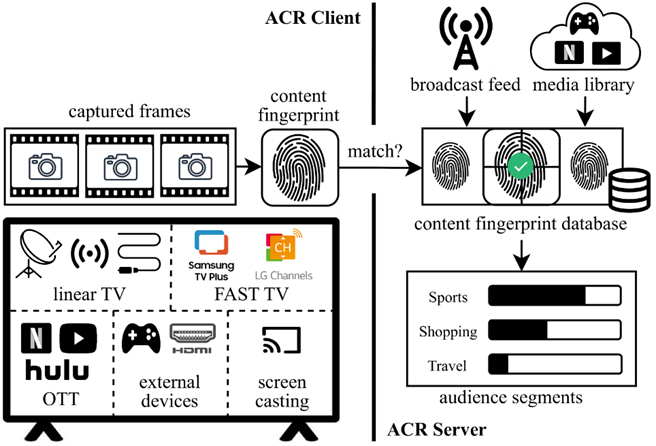Man
Professional
- Messages
- 3,225
- Reaction score
- 1,016
- Points
- 113
Built-in technology allows the smart TV to be a secret spy in your living room.
A group of scientists has found that LG and Samsung smart TVs have built-in technology that uses screenshots to track what users are watching. The technology is called Automatic Content Recognition (ACR), and its work is described in the researchers' report.
ACR is a technology that allows smart TVs to track what a user is viewing by comparing the content displayed on the screen with a database. After that, the corresponding advertisements are shown to the owner of the TV. This technology is built directly into the operating system of TVs and is widely used by major manufacturers, including Samsung and LG.

ACR Operation in Smart TVs
The authors of the study conducted a series of experiments to evaluate the performance of ACR, comparing its performance in different viewing scenarios: linear TV, streaming using the manufacturer's own apps, watching content through third-party applications (for example, Netflix), using an HDMI connection, and others. In addition, the researchers examined how privacy settings affect ACR and found that if you opt out of tracking, traffic to ACR servers stops.
Another aspect of the study was the comparison of ACR's work in different countries – the UK and the US. The results showed that smart TVs in these countries come into contact with different ACR domains, and the operation of the technology is also different. For example, in the US, ACR remains active even when using the built-in streaming app, while in the UK, ACR activity decreases in such cases.
The researchers found that ACR works even when using a smart TV as an external display via HDMI. Screenshots are taken several times per second, but the data is transferred to the server every 15 seconds. Interestingly, while watching streaming services such as Netflix or YouTube, ACR data transmission does not occur.
In addition, it was noted that logging into the account does not affect the operation of ACR - tracking occurs in any case, but the complete refusal of advertising and tracking leads to the cessation of sending data to the ACR servers. In addition, different ACR servers are used for each geographic area, which is likely due to compliance with local privacy laws.
The study revealed differences in ACR behavior between the two major brands. For example, LG TVs send data to a single domain owned by Alphonso, while Samsung sends data to multiple domains associated with Samsung Ads. At the same time, differences in the frequency of data transmission and the amount of information transmitted may be due to the peculiarities of the algorithms for generating content fingerprints.
The study also confirmed that while it is possible to disable ACR in privacy settings, the process of disabling can be complex and requires navigating through numerous menu sections.
Source
A group of scientists has found that LG and Samsung smart TVs have built-in technology that uses screenshots to track what users are watching. The technology is called Automatic Content Recognition (ACR), and its work is described in the researchers' report.
ACR is a technology that allows smart TVs to track what a user is viewing by comparing the content displayed on the screen with a database. After that, the corresponding advertisements are shown to the owner of the TV. This technology is built directly into the operating system of TVs and is widely used by major manufacturers, including Samsung and LG.

ACR Operation in Smart TVs
The authors of the study conducted a series of experiments to evaluate the performance of ACR, comparing its performance in different viewing scenarios: linear TV, streaming using the manufacturer's own apps, watching content through third-party applications (for example, Netflix), using an HDMI connection, and others. In addition, the researchers examined how privacy settings affect ACR and found that if you opt out of tracking, traffic to ACR servers stops.
Another aspect of the study was the comparison of ACR's work in different countries – the UK and the US. The results showed that smart TVs in these countries come into contact with different ACR domains, and the operation of the technology is also different. For example, in the US, ACR remains active even when using the built-in streaming app, while in the UK, ACR activity decreases in such cases.
The researchers found that ACR works even when using a smart TV as an external display via HDMI. Screenshots are taken several times per second, but the data is transferred to the server every 15 seconds. Interestingly, while watching streaming services such as Netflix or YouTube, ACR data transmission does not occur.
In addition, it was noted that logging into the account does not affect the operation of ACR - tracking occurs in any case, but the complete refusal of advertising and tracking leads to the cessation of sending data to the ACR servers. In addition, different ACR servers are used for each geographic area, which is likely due to compliance with local privacy laws.
The study revealed differences in ACR behavior between the two major brands. For example, LG TVs send data to a single domain owned by Alphonso, while Samsung sends data to multiple domains associated with Samsung Ads. At the same time, differences in the frequency of data transmission and the amount of information transmitted may be due to the peculiarities of the algorithms for generating content fingerprints.
The study also confirmed that while it is possible to disable ACR in privacy settings, the process of disabling can be complex and requires navigating through numerous menu sections.
Source
